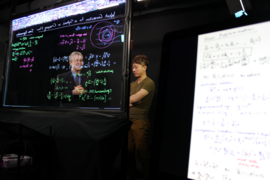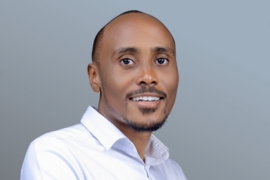When June Odongo interviewed early-career electrical engineer Cynthia Wacheke for a software engineering position at her company, Wacheke lacked knowledge of computer science theory but showed potential in complex problem-solving.
Determined to give Wacheke a shot, Odongo turned to MIT OpenCourseWare to create a six-month “bridging course” modeled after the classes she once took as a computer science student. Part of MIT Open Learning, OpenCourseWare offers free, online, open educational resources from more than 2,500 courses that span the MIT undergraduate and graduate curriculum.
“Wacheke had the potential and interest to do the work that needed to be done, so the way to solve this was for me to literally create a path for her to get that work done,” says Odongo, founder and CEO of Senga Technologies.
Developers, Odongo says, are not easy to find. The OpenCourseWare educational resources provided a way to close that gap. “We put Wacheke through the course last year, and she is so impressive,” Odongo says. “Right now, she is doing our first machine learning models. It’s insane how good of a team member she is. She has done so much in such a short time.”
Making high-quality candidates job-ready
Wacheke, who holds a bachelor’s degree in electrical engineering from the University of Nairobi, started her professional career as a hardware engineer. She discovered a passion for software while working on a dashboard design project, and decided to pivot from hardware to software engineering. That’s when she discovered Senga Technologies, a logistics software and services company in Kenya catering to businesses that ship in Africa.
Odongo founded Senga with the goal of simplifying and easing the supply chain and logistics experience, from the movement of goods to software tools. Senga’s ultimate goal, Odongo says, is to have most of their services driven by software. That means employees — and candidates — need to be able to think through complex problems using computer science theory.
“A lot of people are focused on programming, but we care less about programming and more about problem-solving,” says Odongo, who received a bachelor’s degree in computer science from the University of Massachusetts at Lowell and an MBA from Harvard Business School. “We actually apply the things people learn in computer science programs.”
Wacheke started the bridging course in June 2022 and was given six months to complete the curriculum on the MIT OpenCourseWare website. She took nine courses, including: Introduction to Algorithms; Mathematics for Computer Science; Design and Analysis of Algorithms; Elements of Software Construction; Automata, Computability, and Complexity; Database Systems; Principles of Autonomy and Decision Making; Introduction to Machine Learning; and Networks.
“The bridging course helped me learn how to think through things,” Wacheke says. “It’s one thing to know how to do something, but it’s another to design that thing from scratch and implement it.”
During the bridging course, Wacheke was paired with a software engineer at Senga, who mentored her and answered questions along the way. She learned Ruby on Rails, a server-side web application framework under the MIT License. Wacheke also completed other projects to complement the theory she was learning. She created a new website that included an integration to channel external requests to Slack, a cross-platform team communication tool used by the company’s employees.
Continuous learning for team members
The bridging course concluded with a presentation to Senga employees, during which Wacheke explained how the company could use graph theory for decision-making. “If you want to get from point A to B, there are algorithms you can use to find the shortest path,” Wacheke says. “Since we’re a logistics company, I thought we could use this when we’re deciding which routes our trucks take.”
The presentation, which is the final requirement for the bridging course, is also a professional development opportunity for Senga employees. “This process is helpful for our team members, particularly those who have been out of school for a while,” Odongo says. “The candidates present what they’ve learned in relation to Senga. It’s a way of doing continuous learning for the existing team members.”
After successfully completing the bridging course in November 2022, Wacheke transitioned to a full-time software engineer role. She is currently developing a “machine” that can interpret and categorize hundreds of documents, including delivery notes, cash flows, and receipts.
“The goal is to enable our customers to simply feed those documents into our machine, and then we can more accurately read and convert them to digital formats to drive automation,” Odongo says. “The machine will also enable someone to ask a document a question, such as ‘What did I deliver to retailer X on date Y?’ or ‘What is the total price of the goods delivered?’”
The bridging course, which was initially custom-designed for Wacheke, is now a permanent program at Senga. A second team member completed the course in October 2023 and has joined the software team full time.
“Developers are not easy to find, and you also want high-quality developers,” Odongo says. “At least when we do this, we know that the person has gone through what we need.”











